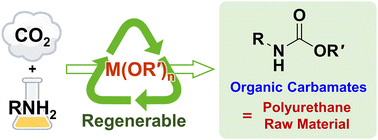Synthesis of organic carbamates as polyurethane raw materials from CO2: the quest for metal alkoxides as regenerable reagents
Abstract
It is well known that the utilization of carbon dioxide (CO2) for chemical materials is attracting research attention from the viewpoint of the carbon cycle. To contribute to the reduction of CO2 emission through such CO2 utilization reactions and counteract global climate change, the target compounds should be core chemical products that are distributed in large quantities and used for a long time. One such synthetic target is isocyanates that are used as raw materials for the production of polyurethanes, which are versatile polymeric materials with a service life of approximately 10 years. However, since direct synthesis of isocyanate from CO2 is quite difficult due to equilibrium constraints, a method via the use of its alcohol adduct, organic carbamate, as a precursor has been proposed. In this Perspective, we present regenerative metal alkoxide reactants, such as tin alkoxide, titanium alkoxide, and alkoxysilane, as environmentally benign reactants for the synthesis of organic carbamates from CO2. We also present a practical and environmentally friendly method for the highly efficient synthesis of various organic carbamates, including industrially important diisocyanate precursors, from 1 atm CO2 using alkoxysilanes. Furthermore, prospects for the practical application of these carbamate synthesis reactions are also discussed.

- This article is part of the themed collection: 2022 Frontier and Perspective articles


 Please wait while we load your content...
Please wait while we load your content...